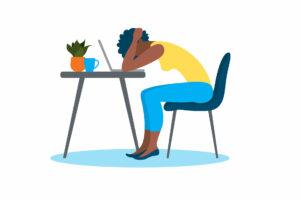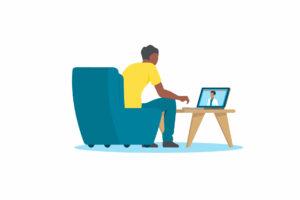Uniting to advance behavioral health equity
Behavioral health equity: The big picture
The landscape of the American workforce is changing. Not only is the way we work evolving, but the workforce is becoming more diverse. And with behavioral health conditions on the rise1—and projected to contribute to $16 trillion in lost productivity by 20302— behavioral health has come to the forefront of employer concerns. Stark disparities exist across racial, geographic and
socioeconomic groups and have been further highlighted by the COVID-19 pandemic. For employers to meet the behavioral health needs of their employees, it’s crucial for all of us to address these disparities. Together, we can adopt a broader and more mindful approach to behavioral health, reducing stigma, building trust and making it more equitable for all. Advancing behavioral health equity is one of four priority areas of focus in Blue Cross and Blue Shield companies’ National Health Equity Strategy.
What do we mean by “behavioral health”?
Over time, a broader definition of behavioral health has emerged to include a full continuum of conditions, from the most severe mental health disorders to the everyday stressors—financial debt, social media pressure and work/life balance, to name a few.3 Behavioral healthcare encompasses a broad scale of prevention, intervention, treatment and recovery support services.4
Behavioral health equity: scale of impact
Behavioral health disparities are having a serious impact on diverse groups, especially people of color. This is an issue that desperately needs to be addressed, given that people of color are projected to account for over half of the U.S. population by 2050.5 The first step in providing support for your workforce is grasping the extent of these disparities.
Receiving care
- Only 1 in 3 Black adults who need mental healthcare receive it.6
- Only about 34% of Hispanic/Latino adults with mental health conditions receive treatment each year, compared to the U.S. average of 45%.7
Starting and staying in treatment
- Due to stigma, people of color are 20-50% less likely to seek out mental healthcare, and 40-80% more likely to end treatment prematurely.8
- Rates of prescription treatment for diagnosed major depression are 33% lower for Hispanic communities and 13% lower for Black communities than for white communities. Rates for counseling for diagnosed major depression are also 21% lower for Hispanic communities than white communities.9
Underdiagnosis
- Likely due to underdiagnosis, majority Black and Hispanic communities have a 30-40% lower diagnosis rate of major depression than white communities.10
- Early and consistent screening combined with the context of known risk factors has been found to help detect and treat postpartum depression.11 But according to a recent survey from Blue Cross Blue Shield Association (BCBSA), 34% of Black women and 38% of Hispanic women said they were not screened for post-partum depression or did not know if they were screened.12 Learn more about maternal health disparities.
Geographic impact
- 80% of all rural counties are lacking even a single psychiatrist.13 This is especially relevant given the change in moving patterns over the last two years — six of the top ten states with the highest inbound moving percentages of 2021 are among the 20 least densely populated states in America.14
Socioeconomic status
- Socioeconomic status also reflects sizable disparities that have been amplified by COVID-19. 35% of adults with less than $40K a year in household income reported a major negative impact to their mental health due to the pandemic, versus 24% with $40K-$89K and 17% with $90K or more.15
- Adults who are insured or low-income are more likely to experience serious mental health conditions than individuals with insurance or higher incomes.16
Chronic conditions and comorbidities
- Those diagnosed with a chronic illness are twice as likely to have a behavioral health condition, and those with a behavioral health condition are more likely to have a chronic illness.17 Comorbidities such as this are associated with worse health outcomes, more complex clinical management and increased healthcare costs.18
- People of color are up to two times more likely to have major long-term conditions when compared to white people.19
Impact on employers
The persistence of behavioral health disparities among diverse segments of the workforce could have significant impacts on businesses. Depression is one condition in particular that has massive cost implications both to the well-being of the workforce—especially people of color and other disadvantaged groups—and to organizations.
The flu costs $1,000 in lost productivity per employee per year and $10.4B in direct medical costs, while depression cost $9.450 in lost productivity per employee per year and $110B in direct medical costs.21 Employees with depression also miss between 6 and 25 more days per year and suffer from impaired work performance between 13% and 29% of the time.22 The estimated cost of depression and anxiety to the global economy is $1 trillion per year in lost productivity.23
The healthcare costs for treating individuals with chronic medical and behavioral health conditions are 2-3X higher than for those without behavioral health conditions.24 In dollar terms, patients with untreated depression and a chronic illness have monthly healthcare costs that average $560 higher than those with just a chronic disease. Higher levels of comorbidity among people of color make this even more urgent.25
Understanding behavioral health disparities
Advancing behavioral health equity involves understanding the root causes of these disparities. Below are some key influencing factors specific to behavioral health disparities.
ZIP code and access to treatment
As rurality increases, the percentage of counties with behavioral health resources decreases. 80% of rural counties lack a single psychiatrist.26 47% lack a psychologist and 81% lack a psychiatrist nurse practitioner. More than a quarter (27%) of rural counties do not have a social worker, 18% lack a behavioral health counselor and 13% have no behavioral health providers.27 Furthermore, healthcare costs are especially prohibitive for people of color, who are more likely to have lower socioeconomic status. Factors like a lack of or insufficient insurance, costly copays and limited proximity to providers may prevent them from seeking care in the first place.28
Literacy and education
Historical adversity in encounters with the healthcare system has led to socioeconomic disparities in the Black community.29 These disparities, including race-based exclusion from health and educational resources, may give rise to worse mental health outcomes.30 It’s also been shown that Black patients and patients with less education are less likely to receive a response when seeking help from mental healthcare providers, and that patients with lower levels of literacy found it more challenging to navigate the mental healthcare system (such as filling out paperwork). Both the structure of mental healthcare and the actions of providers can maintain and exacerbate behavioral health disparities.31
Stigma
Stigma can be particularly strong within Black and Hispanic communities. 63% of Black adults believe that a mental health condition is a sign of personal weakness, which could lead those with a mental health challenge to worry about discrimination.32 According to a recent BCBSA survey, 54% of Black respondents and 47% of Hispanic respondents reported that individuals with mental health conditions in their communities “are looked down upon.” That was the perception of only 38% of white respondents.33
Provider bias and inequality of care
Research shows that behavioral health conditions may be underdiagnosed among racial and ethnic minorities. These lower diagnoses are likely in part due to lack of quality care.34 Survey findings show that Black and Hispanic people are more likely to prefer providers of the same race or ethnicity,35 as provider bias — both conscious and unconscious — and a lack of cultural competency can result in misdiagnosis and inadequate treatment. All of this, as well as the limited availability of behavioral health providers of color, can ultimately lead to mistrust of mental health professionals and create a barrier for many people of color to engage in treatment.36
Did you know? 
63%
of Black adults believe that a mental health condition is a sign of personal weakness, which could lead those with a mental health challenge to worry about discrimination.37
What we can do together
 Collaborate with your health plan partner
Collaborate with your health plan partner
Advancing behavioral health equity takes all of us. Your health plan partner can help.
- Ask your health plan partner how they are confronting gaps in behavioral healthcare for disadvantaged populations.
- Ensure steps are being taken with providers to increase cultural awareness, address unconscious bias and improve behavioral health outcomes.
- Inquire about key community organizations that may serve the needs of your employees.
 Normalize behavioral healthcare
Normalize behavioral healthcare
It’s important to make behavioral healthcare business as usual within the workplace.
- Educate senior leaders and frontline managers on behavioral health, including various barriers to care that populations face, and the importance of speaking openly about mental health with their workforce.
- Encourage starting the mental health conversation from employee onboarding—especially in benefits conversations—and continuing beyond. Send regular reminders about all available resources.
- Implement Employee Resource Groups (ERGs) as a part of Diversity, Equity and Inclusion (DEI) strategies. These groups can help raise mental health awareness and create a forum for employees to support one another, allowing them to bring more of their full selves to work.
- Implicit bias training may also be an important aspect for leaders and people managers. In all your efforts, make sure you are providing tools to create a psychologically safe environment that builds trust through listening and cultural humility.
 Make accessing care less cost prohibitive
Make accessing care less cost prohibitive
Collaborate with your health plan partner and others to break down barriers to make care more affordable and accessible.
- Explore limiting or eliminating office visit copays and offering no-cost screenings.
- Drive awareness of outside local resources—many of which are available at little or no cost.
- Consider providing access to screenings, counseling and care on-site and offering paid time off for behavioral healthcare.
 Expand coverage for virtual care
Expand coverage for virtual care
Embrace virtual care to help ensure all employees have equitable access to quality healthcare.38

- Virtual behavioral healthcare is not only convenient, but it also helps those with high levels of anxiety to overcome stigma and feel more comfortable expressing themselves in the comfort of their own home.
- People also feel safer due to the ongoing COVID-19 pandemic.39 Be sure to highlight the benefits and effectiveness of virtual care options.
Arkansas Blue Cross and Blue Shield addresses access to behavioral healthcare while Normalizing the Conversation
In Arkansas, nearly 38% of adults reported symptoms of anxiety and depression in a 2021 survey40, yet behavioral healthcare is often difficult to access, particularly in rural parts of the state. And while most minority groups, especially African Americans and Hispanic Americans, report lower rates of behavioral health conditions than white Americans, this is primarily due to the under-diagnosis of behavioral health conditions driven principally by access and stigma.
In 2021, the Blue & You Foundation for a Healthier Arkansas committed $5.29 million to support six Arkansas-based partners and leaders to expand behavioral health resources within the state. The grants support state-based programs that connect people to much needed behavioral and emotional health services, including the UAMS Health AR ConnectNow platform, which is available 24 hours a day, 7 days a week, to help all Arkansans connect with mental health professionals. Recognizing that emotional health challenges are more common than ever on high school and college campuses, support has also been given to the National Alliance on Mental Illness in Arkansas to raise mental health awareness and advocate for students who need help.
Arkansas Blue Cross is also working to remove the stigma around behavioral healthcare and improve accessibility by helping to Normalize the Conversation through a statewide advertising campaign that promotes Arkansas-based behavioral health programs and encourages Arkansans to talk about their behavioral healthcare needs. The campaign also is running Spanish language advertisements on Telemundo and includes a Spanish language website. By normalizing the conversation about this important, often misunderstood topic, we can foster healthier, happier, more informed and empowered communities.
Did you know?
3X more likely
Estimates show that those of the lowest socioeconomic status are up to 3X more likely to have a mental health condition.41
Join the movement to advance behavioral health equity
Use data to inform more equitable support
Gaining a thorough understanding of behavioral health disparities and their root causes is the first step toward achieving more equitable care. Better data is crucial for pinpointing disparities, improving outcomes and addressing unconscious bias. Ask your health plan partner how you can work together to improve the collection of data that will help drive education, accessibility and equity within your workforce. Employers can also utilize ERGs to help identify and raise awareness of behavioral health challenges that certain groups are facing.
Make it safe to express mental health concerns in the workplace
Train your leaders to be empathetic, trustworthy and humble listeners. Encourage them to be open about their own behavioral health concerns (to the extent they are comfortable) to help eliminate taboos around the subject.
Reach out, to better reach everyone
Collaboration is key in the effort to advance behavioral health equity. Approach your health plan partner for concrete, actionable solutions to these challenges, and ask if they know of any local community resources to further support the overall health of your workforce. If we come together, we can address these disparities, build trust with employees, reduce barriers to care and normalize the importance of behavioral health.
1 Ages 18-64, Blue Cross Blue Shield Health Index, 2018.
2 Kelly McCain and Philip Campbell, “Declines in Mental Health Workforce Need to Be Met by More Rigorous Employer
Support,” Scientific American, Sept. 14, 2021.
3 Blue Cross Blue Shield Association, Making Full Health the Focus, 2020.
4 “Behavioral Health vs. Mental Health,” Alvernia University.
5 Nambi Ndugga and Samantha Artiga, “Disparities in Health and Health Care: 5 Key Questions and Answers,” KFF (Kaiser Family
Foundation), May 11, 2021.
6, 30, 32, 36, 37 “Identity and Cultural Dimensions: Black/African American,” Your Journey, National Alliance on Mental Illness (NAMI).
7 National Alliance on Mental Illness (NAMI), “Hispanic/Latinx,” 2021.
8 Neil Krishan Aggarwal, et al., “Clinician Descriptions of Communication Strategies to Improve Treatment Engagement by Racial/Minorities in
Mental Health Services: A Systematic Review,” Patient Education and Counseling, Feb. 2016, 198–209, cited in National Center for Biotechnology
Information/US National Library of Medicine, National Institutes of Health.
9, 10, 33, 35, 39 Blue Cross Blue Shield Association, Analysis on Racial Disparities in Diagnosis & Treatment of Major Depression, 2022.
11 Zoleykha Asgarlou, Mohammad Arzanlou, and Mohammad Mohseni, “The Importance of Screening in Prevention of Postpartum Depression,”
Iranian Journal of Public Health, May 2021, 1072–1073, cited in National Center for Biotechnology Information/US National Library of Medicine,
National Institutes of Health.
12 Blue Cross Blue Shield Association, Maternal Health Survey. 2020.
13, 26 New American Economy, “New Study Shows 60 Percent of U.S. Counties Without a Single Psychiatrist, One-Third of All Psychiatrists
Nationwide Trained Abroad,” Oct. 23, 2017.
14 Annual 2021 United Van Lines National Movers Study, United Van Lines, Jan. 3, 2022.
15 Nirmita Panchal, Rabah Kamal, and Cynthia Cox, “The Implications of COVID-19 for Mental Health and Substance Use,” KFF (Kaiser Family
Foundation), Feb. 10, 2021.
16 The Costs and Consequences of Disparities in Behavioral Health Care, National Conference of State Legislatures, Feb. 2018.
17, 25 Steven Ross Johnson and Harris Meyer, “Behavioral Health: Fixing a System in Crisis,” Modern Healthcare, Jun. 12, 2017.
18 Jose M. Valderas, MD, et al., “Defining Comorbidity: Implications for Understanding Health and Health Services,” Annals of Family Medicine,
July 2009, 7(4): 357–363.
19 Rachel Reiff Ellis, “Minorities and Chronic Disease: Obstacles to Care,” WebMD, Oct. 7, 2020.
20 Center for Workplace Mental Health, American Psychiatric Association Foundation, “Investing in a Mentally Healthy Workforce Is Good for
Business,” 2020.
21 Don Mordecai, MD, “Mental Health at Work – Why Stigma Is a Workforce Health Issue,” Kaiser Permanente Business, March 18, 2019.
22 “The High Cost of Mental Disorders: Facts for Employers,” One Mind At Work.
23 Mental Health in the Workplace, World Health Organization.
24 Milliman Research Report, “Potential Economic Impact of Integrated Medical-Behavioral Healthcare, Implications for Psychiatry,” 2014.
27 Christine Hancock, MD, MS, et al., Treating the Rural Opioid Epidemic, National Rural Health Association, Feb. 2017.
28, 34 Blue Cross Blue Shield Association, ”Breaking Through Barriers to Improve Workforce Behavioral Health,“ June 2021.
29 Steven Starks, MD, “Working with African American/Black Patients,” American Psychiatric Association.
31 There’s Research on That! (blog); “Inequality and Access to Mental Health Care,” by Mahala Miller, posted Apr. 1, 2021.
38 “Virtual Mental Healthcare Breaks Down Barriers and Increases Access to Quality Care,” Teladoc Health.
40 https://www.kff.org/statedata/mental-health-and-substance-use-state-fact-sheets/arkansas
41 Young-Mee Kim, PhD, and Sung il-Cho, PhD, MD, “Socioeconomic Status, Work-Life Conflict, and Mental Health,” American Journal of
Industrial Medicine, May 17, 2020.